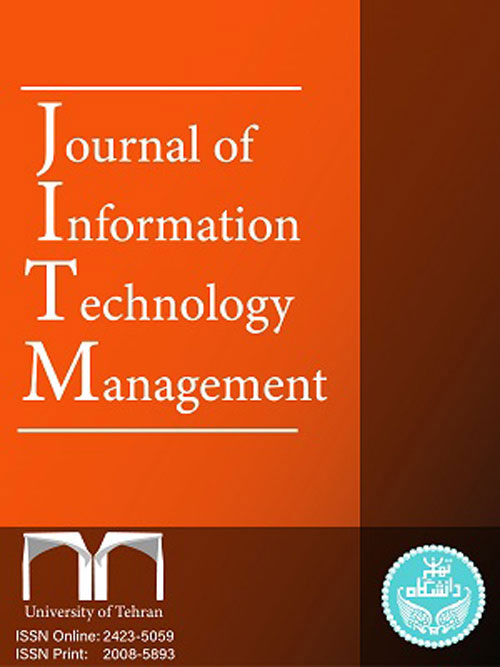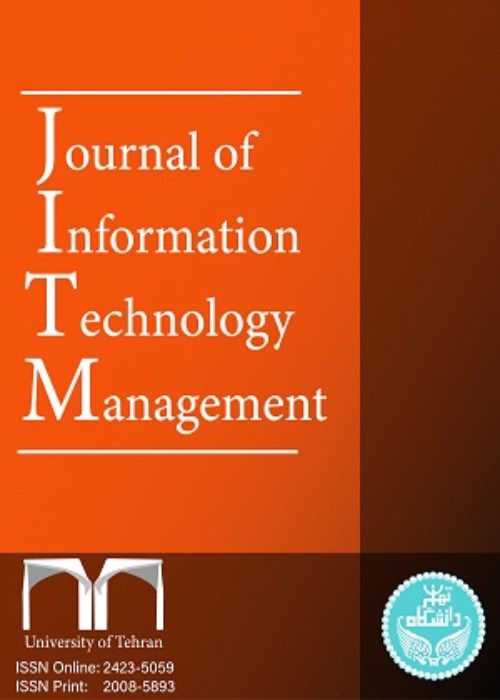فهرست مطالب

Journal of Information Technology Management
Volume:11 Issue: 1, Winter 2019
- تاریخ انتشار: 1398/02/09
- تعداد عناوین: 6
-
-
Pages 1-23
Given the complexities of supply chain networks, the firms consider modern technologies as a potential factor to improve their supply chain performances. One of these technologies is the Internet of Things (IoT). Hence, the main purpose of this study has been to achieve the conceptual model of the IoT implementation in hospital supply chains. Considering the qualitative nature of the study, relevant articles were specified through library research and collecting the related literature. The outputs obtained were analyzed using the meta-synthesis method and the grounded theory. Then the selected articles were extracted and the grounded theory was used to obtain the conceptual model of the IoT implementation in hospital supply chains. The research results indicated that the model featured 7 main categories, 19 subcategories and 86 codes. The results present a conceptual model for the implementation of the IoT in hospital supply chains including an explanation of the main research category, drivers, prerequisites and enablers, environmental and contextual conditions, challenges, technology implementation strategies, and results and outcomes.
Keywords: Internet of Things, Supply Chain, Hospital Industry, Technology Implementation -
Pages 24-41Social support is the physical and emotional comfort given to someone in times of need or crises and it is especially important for maintaining good physical and mental health. Despite the contribution of intelligent technological devices, which have led to the availability of various types of social support systems, the latter are still not widely known to many. These support systems are currently available in many versions, such as in tablets and smartphones, where many health information systems have been created specifically to accommodate to the needs of current mobile healthcare consumers. In this paper, we systematically review the role of social support provided via health information systems and report a qualitative study that investigates the perceptions of healthcare professionals and consumers towards incorporating social support in self-care applications. The results obtained through our study reveal that social support is associated with better health management and is a vital component to be incorporated in any novel health information system. Likewise, the results are supported by our qualitative study that indicates healthcare professionals and consumers emphasize the inclusion of the social support component in self-care applications to achieve better health outcomes.Keywords: Social Support, Self-care, Health Self-management, Health Information Systems, Health Informatics
-
Pages 42-59
The development teams who are geographically spread, culturally mixed and mainly depend on information and communication technology (ICT) for communication is defined as a global virtual teams (GVTs). Despite the advancement of technologies, achieving the efficient performance of GVTs remains a challenge. The reviewed literature has highlighted the importance of training and development, organizational commitment and motivation in enhancing the performance of GVTs. This study aims to identify the key performance indicators (KPIs), measures, and variables for assisting the GVT performance in global software development projects (GSD). In addition, this study aims to measure the GVTs performance involving online training and development, organizational commitment, and motivation in GSD projects. A survey was conducted among 103 respondents. Then, the performance measurement model (PMM) for GVTs in GSD projects was proposed based on the result of the survey. Finally, the project managers validated the study model. The proposed PMM includes four major components, namely performance measurement processes, mapping strategy for performance evaluation, measurements and performance analysis. The results showed the validity of the proposed model and confirmed that the PMM can assist project managers in measuring the performance of GVTs in GSD Projects.
Keywords: Global software development (GSD), Global virtual teams (GVTs), Information, communication technology (ICT), Performance measurement model (PMM) -
Pages 60-75
This study investigates the constructs and related theories that drive social capital in energy sector from the intention perspectives. This research uses theories of ‘social support’ and ‘planned behaviour’ alongside satisfaction and perceived value to propose a research model that drives social capital for energy sectors in Malaysia. The model reveals that the Theories of Planned Behaviour (TPB) and Social Support Theory (SST) alongside satisfaction and perceived value factors promote social capital development in energy sectors. Using PLS–SEM to analyse data gathered from energy sector employees in Malaysia, this research demonstrates that social capital is present when there is trust and loyalty among the users and positively effects energy sectors in terms of the productivity, effectiveness, efficiency and profitability. The study also contributes to the understanding of individuals' use of social capital in energy sector. A survey is adapted and distributed to 100 respondents as a mean to study on the validity and reliability of the research factors. Results indicate that all seven hypotheses proposed significantly influence social capital.
Keywords: Social Commerce, Social Capital, Energy Sector, Theory of Planned Behaviour (TPB), Social Support Theory (SST) -
Pages 76-101In order to achieve the sensing, communication and processing tasks of Wireless Sensor Networks, an energy-efficient routing protocol is required to manage the dissipated energy of the network and to minimalize the traffic and the overhead during the data transmission stages. Clustering is the most common technique to balance energy consumption amongst all sensor nodes throughout the network. In this paper, a multi-objective bio-inspired algorithm based on the Firefly and the Shuffled frog-leaping algorithms is presented as a clustering-based routing protocol for Wireless Sensor Networks. The multi-objective fitness function of the proposed algorithm has been performed on different criteria such as residual energy of nodes, inter-cluster distances, cluster head distances to the sink and overlaps of clusters, to select the proper cluster heads at each round. The parameters of the proposed approach in the clustering phase can be adaptively tuned to achieve the best performance based on the network requirements. Simulation outcomes have displayed average lifetime improvements of up to 33.95%, 32.62%, 12.1%, 13.85% compared with LEACH, ERA, SIF and FSFLA respectively, in different network scenarios.Keywords: Wireless Sensor Networks, Clustering, Bio-inspired Algorithm, Firefly Algorithm, Shuffled Frog Leaping Algorithm
-
Pages 102-129In today's world, the Internet of Things (IoT), which is a fairly new technology, has become a popular topic for discussion. Meanwhile, the increasing demand for personalized healthcare with the assistance of new technologies has created new applications called e-health IoT applications; however, researchers are still attempting to find its applications, therefore they have not been able to focus on comparing these applications. We have aimed at understanding the benefits of e-health IoT applications in comparison to one another. Therefore, this study is an attempt to provide a list of e-health IoT applications for individuals and to prioritize them. The Fuzzy Analytical Hierarchy Process (FAHP) method has been used, which is a method for Multi-Criteria Decision Making (MCDM) and a useful tool for prioritizing multiple alternatives based on criteria. Eight important criteria, based on a comprehensive literature review and experts’ opinions, were determined. Then, by using the FAHP method, the weight of each criterion was calculated. As a result, seven applications identified for individuals were prioritized based on the weight of each criterion and the score of each application in each criterion. Health Effectiveness, Empowerment, Safety, Privacy, and Peace of Mind are the most important criteria in e-health IoT applications for individuals; Cost Saving, round-the-clock Access, and Time-Saving are in the next levels of importance. The results also show that Chronic disease management, Medication reminders, Health monitoring, Air quality, Fall detection, Sleep control and Fitness were respectively ranked as first, second, third, fourth, fifth, sixth and seventh among the IoT applications.Keywords: Internet of Things (IoT), Health IoT application, Healthcare Devices, Electrical Healthcare (E-Health)


